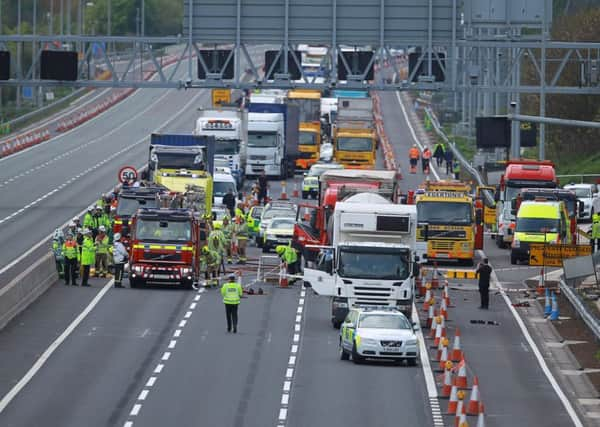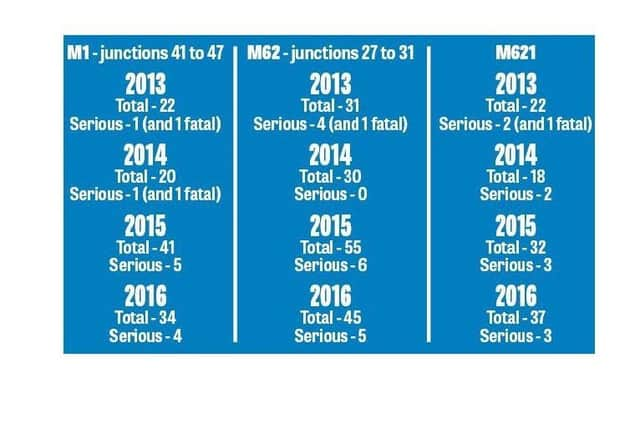How many motorway collisions in Leeds result in serious injuries or lives lost?


The vast majority result in only damage to the vehicles involved and inconvenience for those stuck in the resulting tailbacks, but there are still dozens every year that end in injuries or fatalities.
In the first part of a week-long series focusing on the policing, management and development of the motorway network in Leeds, the YEP takes a look at the latest figures.


Advertisement
Hide AdAdvertisement
Hide AdHighways Agency data for 2017 is not yet available, but figures secured through a Freedom of Information request reveal there were four fatal collisions on sections of the M62, M1 and M621 passing through Leeds over the course of the four previous years.
A further 36 collisions resulted in at least one person being seriously injured, meaning the number of people seriously hurt could be higher still.
Mark Ramsden, Highways England’s service delivery team leader for Yorkshire and the Humber, said: “Safety is Highways England’s top priority and we operate some of the safest roads in the world. We are determined to meet our target to reduce the number of people who are killed or seriously injured on the motorway network by 40 per cent by 2020.
“We continue to develop innovative programmes to improve road user behaviour and will look for new ways to make our own people safer when they work on the roads. We are also working to keep our roads in good condition through our ongoing resurfacing and renewals programme.”
Advertisement
Hide AdAdvertisement
Hide AdHe said one of the innovative methods being used was the introduction of ‘smart motorways’, which were proven to be at least as safe as traditional motorways.
“More than 95 per cent of smart motorways are covered by CCTV systems with infa-red capability, signals and electronic message signs on an overhead gantry and concrete barrier down the centre of the motorway which lowers the potential injury incidents,” he said.
The new technology was introduced between Brighouse (junction 25) and Rothwell (junction 30) of the M62 in 2013 and Wakefield (junction 39) and Lofthouse (junction 42) of the M1 in 2016.
Chief Insp Mark Bownass, of West Yorkshire Police’s Roads Policing Unit, said the actions of some drivers would always limit the effectiveness of smart motorways in reducing collisions.
Advertisement
Hide AdAdvertisement
Hide Ad“It’s never going to eradicate people driving erratically and causing injuries,” he said. “I was driving home the other day and there were people ignoring the red X signs – it’s totally dangerous. They’re on there because it means there’s something up ahead. They’ll come speeding up into the back of a highways vehicle or another vehicle.”
Leading road safety charity IAM Roadsmart said drivers had to realise that it was incidents and not roadworks that caused most delays and problems on the motorway network around Leeds.
Policy and research director Neil Greig said: “Highways England are doing their best to improve congestion through smart motorways, reducing clean up times and providing information but if drivers take their share of the responsibility then traffic can keep flowing smoothly. Driving too close, speeding, driving while tired or ignoring warning gantry signs are all key factors in motorway crashes.
“Constantly scanning ahead and anticipating the actions of other motorway users are key skills that need to be developed. In the long run allowing supervised learners onto motorways will help, but we all need to get the basics right and that includes simple things like making sure you have enough fuel to get to where you want to go.
“A little bit of planning and preparation by both private and company drivers will help us all go a long way.”
